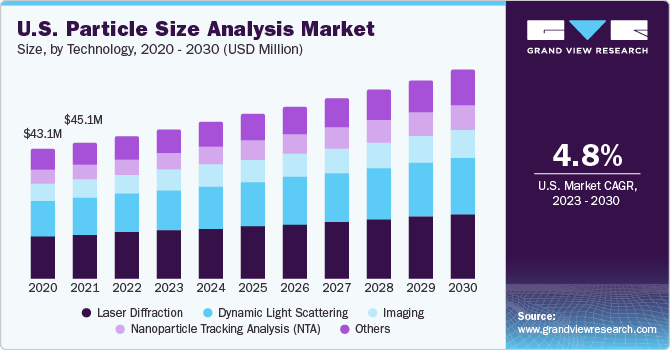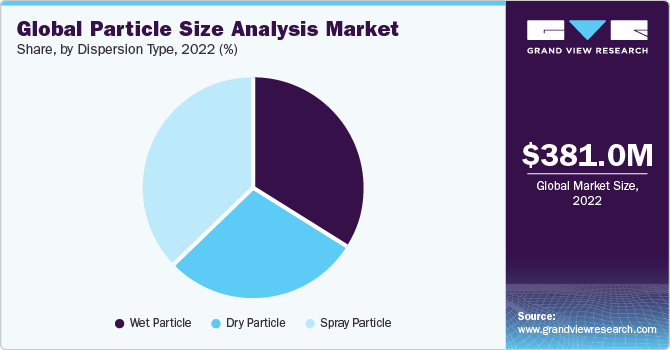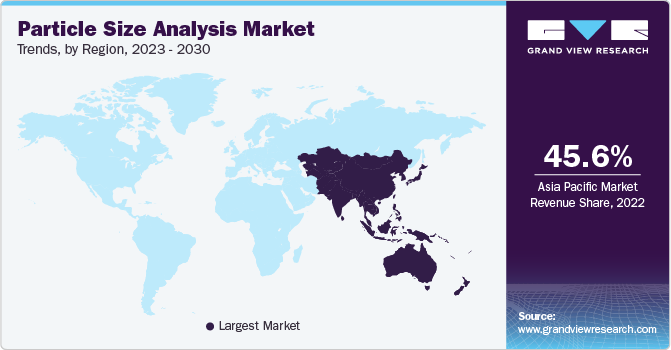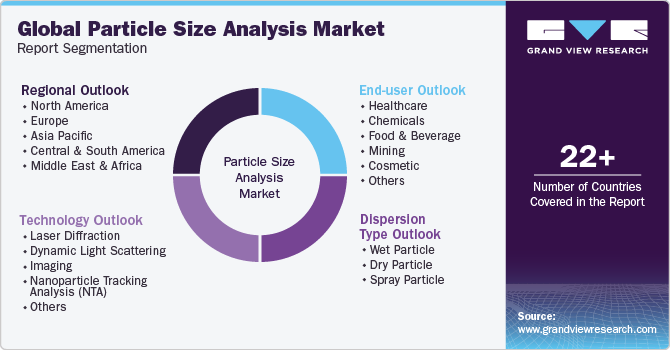
Particle Size Analysis Market Size, Share & Trends Analysis Report By Technology (Imaging, NTA, Laser Diffraction), By End-user (Healthcare, Pharmaceuticals), By Dispersion Type, By Region, And Segment Forecasts, 2023 - 2030
- Report ID: GVR-4-68040-140-8
- Number of Pages: 90
- Format: Electronic (PDF)
- Historical Range: 2018 - 2021
- Industry:Advanced Materials
Particle Size Analysis Market Size & Trends
The globalparticle size analysis market size was estimated at USD 381.0 million in 2022and is anticipated to grow at a compound annual growth rate (CAGR) of 5.4% from 2023 to 2030. The growing research endeavors within the area ofnanotechnologyand the rising demand in industries, such as aerospace, automotive, semiconductor, and pharmaceuticals, have led to market growth. Furthermore, the introduction of advanced particle size analysis methods that deliver enhanced precision and flexibility, when integrated into systems, is anticipated to further stimulate market growth. Particle size analysis supports innovation in various industries by enabling the development of new and improved products with optimized properties and performance.

In addition, the ongoing advancements in particle size analysis instruments and software improve their accuracy, speed, and ease of use, making them more accessible and valuable to a broader range of industries. The market growth is also being propelled by the rising demand for pharmaceutical products. Factors, such as increasing consumer purchasing power, improvements in healthcare infrastructure, advancements in diagnostics, and the easy availability of pharmaceuticals, play pivotal roles in driving this growth. The pharmaceutical sector operates within strict regulatory frameworks, and compliance with these standards is of utmost importance.
Particle size analysis plays a crucial role in ensuring that pharmaceutical products adhere to size specifications and meet regulatory requirements. For instance, AstraZeneca, a prominent pharmaceutical company, reported that global pharmaceutical sales reached USD 1,214 billion in 2022, a significant increase from USD 1,036 billion in 2020. Thus, factors, such as regulatory compliance, drug safety, advanced drug delivery systems, and the need for precise control of particle size in various dosage forms, are anticipated to boost the adoption of particle size analysis. Particle size analysis instruments help industries optimize processes, reduce waste, and improve product quality, resulting in significant cost savings over time.
In addition, the availability of accurate particle size analysis methods encourages the development and introduction of new products and technologies, expanding market opportunities. Particle size analysis instruments are widely adopted as they provide insights into particle characteristics, particle size analysis enables process optimization, leading to increased productivity in manufacturing and research activities. In addition, it is vital for the development and testing of advanced materials used in automotive and aerospace applications, where high performance and safety standards are critical. As international trade continues to grow, adherence to quality standards, including particle size specifications, is essential for products crossing borders.
这将推动市场需求在未来ars. The global market growth is mainly propelled by an increased emphasis on research and development initiatives centered around environmentally friendly and bio-based analytical methods. This aligns with the stringent regulatory frameworks in multiple countries, which are pushing industries to maintain elevated levels of quality control, necessitating precise particle size analysis. Furthermore, as businesses acknowledge the importance of more exact and meticulous measurements, there is a growing demand for advanced particle size analysis techniques.
Dispersion Type Insights
The wet particle dispersion type segment is expected to register a lucrative growth rate of 33.4% from 2023 to 2030. Particle size analysis by wet particle dispersion type is a valuable technique used in various industries to measure and analyze particle sizes in liquid suspensions. As wet dispersion methods offer high accuracy and precision in measuring particle sizes, they are suitable for applications where precise size information is critical.

This, in turn, helps boost the adoption of wet particle dispersion type. The dry particle dispersion type segment accounted for a significant revenue share in 2022. Dry dispersion methods do not alter the properties of the sample, preserving its integrity for further analysis or testing. This is crucial for maintaining sample characteristics. In addition, dry dispersion techniques are ideal for analyzing powder and solid materials, including pharmaceutical powders, minerals, pigments, and polymers.
End-user Insights
The healthcare end-use segment is expected to register a lucrative growth rate of 20.1% from 2023 to 2030. In the development of medical devices, such as drug-eluting stents and implants, particle size analysis is used to characterize coatings, drug carriers, and materials to ensure their safety and performance. Moreover, it is used in the development of diagnostic assays and tests, including immunoassays, lateral flow tests, and point-of-care (PoC) diagnostics, where particle size can impact assay performance.
Thus, the increasing application of particle size analysis instruments in the healthcare sector is anticipated to fuel the segment growth over the forecast period. Researchers in the chemicals industry use particle size analysis to develop advanced materials with specific particle size distributions, tailored for various applications. In addition, the chemicals industry increasingly works with nanoparticles for various applications, including catalysts, coatings, and polymers. Particle size analysis is vital for characterizing and controlling these nanomaterials.
Technology Insights
The laser diffraction technology segment accounted for a market share of 31.4% in 2022. Laser diffraction technology is known for its high accuracy and precision in measuring particle size distributions. It provides detailed and reliable information about particle sizes, making it essential for industries requiring precise measurements. In addition, compliance with stringent regulatory requirements in various industries necessitates precise particle size analysis, making laser diffraction a valuable tool.
The demand for dynamic light scattering (DLS) is anticipated to show lucrative growth over the forecast period. Particle size analysis by DLS technology is driven by several key factors that contribute to its growth and adoption in various industries. DLS is a versatile and widely used technique for measuring particle size and size distribution in both nanometer and micrometer ranges. DLS is known for its high sensitivity to small particles and aggregates, making it suitable for analyzing nanoparticles and macromolecules, thus, thereby fueling the segment growth.
Regional Insights
亚太地区最大的份额占45.6% in 2022. The Asia Pacific regional market serves a wide range of industries, including pharmaceuticals, chemicals, materials science, food & beverages, environmental monitoring, and electronics. The rapid economic growth & industrialization in countries like China and India are driving the demand for particle size analysis equipment across multiple industries. In addition, the pharmaceutical industry in Asia Pacific is expanding, with a focus on drug development, leading to increased demand for particle size analysis in formulation and quality control. North America is another well-established regional market and is expected to continue to grow steadily. It is characterized by a mature industrial base and a strong focus on R&D.

North America is home to a robust pharmaceutical industry, with a significant emphasis on research, drug development, and quality control, driving the demand for particle size analysis solutions. Particle size analysis is crucial in materials science R&D, contributing to innovations in advanced materials and nanotechnology. Ongoing advancements in particle size analysis technology, including improvements in instruments and software, enhance the capabilities and precision of particle size analysis. Europe places significant importance on environmental protection and monitoring, leading to the adoption of particle size analysis instruments and services for environmental assessments. In addition, European research institutions and academia heavily utilize particle size analysis for scientific research and experimentation.
Key Companies & Market Share Insights
The market is highly fragmented with numerous small to large manufacturers and suppliers competing for market share. This fragmentation offers a wide selection of equipment, and customization choices to buyers while catering to specific industry needs. To meet the rising demand from a diverse range of industries, market players are pursuing business growth through strategies, such as mergers & acquisitions, the establishment of new manufacturing facilities, and geographic expansion initiatives. For instance, in May 2023, FRITSCH Milling & Sizing Inc. announced its exclusive partnership with HORIBA Scientific as the sole distributor of the Analysette 28 image sizer. This collaboration aims to provide customers with a reliable solution for precise particle size and shape measurements of powders and bulk solids, covering a measuring range from 20 µm to 20 mm.
Particle Size Analysis Companies:
- Malvern Panalytical Ltd.
- Horiba Ltd.
- Agilent Technologies Inc.
- Microtrac Inc. (Verder Scientific GmbH & Co. KG)
- Beckman Coulter Inc.
- Anton Paar GmbH
- Brookhaven Instruments
- Fritsch GmbH
- Mettler Toledo
- Micromeritics Instrument Corporation
Particle Size Analysis Market Report Scope
Report Attribute |
Details |
Market size value in 2023 |
USD 399.55 million |
Revenue forecast in 2030 |
USD 578.83 million |
Growth rate |
CAGR of 5.4% from 2023 to 2030 |
Base year for estimation |
2022 |
Historical data |
2018 - 2021 |
Forecast period |
2023 - 2030 |
Quantitative units |
Revenue in USD million and CAGR from 2023 to 2030 |
Report coverage |
Revenue forecast, company market position analysis, competitive landscape, growth factors, and trends |
年代egments covered |
Technology, dispersion type, end-user, region |
Regional scope |
North America; Europe; Aisa Pacific; Central & South America; Middle East & Africa |
Country scope |
U.S.; Canada; Mexico; Germany; U.K.; France; Spain; The Netherlands; Italy; China; India; Japan; South Korea; Australia; Brazil; Argentina; UAE; South Africa |
Key companies profiled |
Malvern Panalytical Ltd.; Horiba Ltd.; Agilent Technologies Inc.; Microtrac Inc. (Verder Scientific GmbH & Co. KG); Beckman Coulter Inc.; Anton Paar GmbH; Brookhaven Instruments; Fritsch GmbH; Mettler Toledo; Micromeritics Instrument Corp. |
Customization scope |
Free report customization (equivalent up to 8 analysts working days) with purchase. Addition or alteration to country, regional & segment scope |
Pricing and purchase options |
Avail customized purchase options to meet your exact research needs.Explore purchase options |
Global Particle Size Analysis Market Report Segmentation
This report forecasts revenue growth at global, regional, and country levels and provides an analysis of the latest trends in each of the sub-segments from 2018 to 2030. For this study, Grand View Research has segmented the global particle size analysis market report on the basis of technology, dispersion type, end-user, and region:

Technology Outlook (Revenue, USD Million, 2018 - 2030)
Laser Diffraction
Dynamic Light Scattering
Imaging
Nanoparticle Tracking Analysis (NTA)
Others
Dispersion Type Outlook (Revenue, USD Million, 2018 - 2030)
Wet Particle
Dry Particle
年代pray Particle
End-user Outlook (Revenue, USD Million, 2018 - 2030)
Healthcare
Chemicals
Food & Beverage
Mining
Cosmetic
Pharmaceuticals
Energy
Others
Regional Outlook (Revenue, USD Million, 2018 - 2030)
North America
U.S.
Canada
墨西哥
Europe
Germany
U.K.
France
年代pain
The Netherlands
Italy
Asia Pacific
China
India
Japan
年代outh Korea
Australia
Central & South America
Brazil
Argentina
Middle East & Africa
UAE
年代outh Africa
Frequently Asked Questions About This Report
b.The global particle size analysis market size was estimated at USD 381.0 million in 2022 and is expected to reach USD 399.55 million in 2023.
b.The global particle size analysis market, in terms of revenue, is expected to grow at a compound annual growth rate of 5.4% from 2023 to 2030 and reach USD 578.83 million by 2030.
b.Asia Pacific particle size analysis market had significant market share in 2022. The Asia Pacific particle size analysis market serves a wide range of industries, including pharmaceuticals, chemicals, materials science, food and beverages, environmental monitoring, and electronics.
b.年代ome of the key players operating in the particle size analysis market include Malvern Panalytical Ltd, Horiba Ltd, Agilent Technologies Inc., Microtrac Inc. (Verder Scientific GmbH & Co. KG), Beckman Coulter Inc., among others.
b.The industry is expected to experience growth due to increased research and development in nanotechnology, global adoption of nanotechnology, rising investments in pharmaceutical research, and the growing demand for analyzers across various end-use sectors.
We are committed towards customer satisfaction, and quality service.






